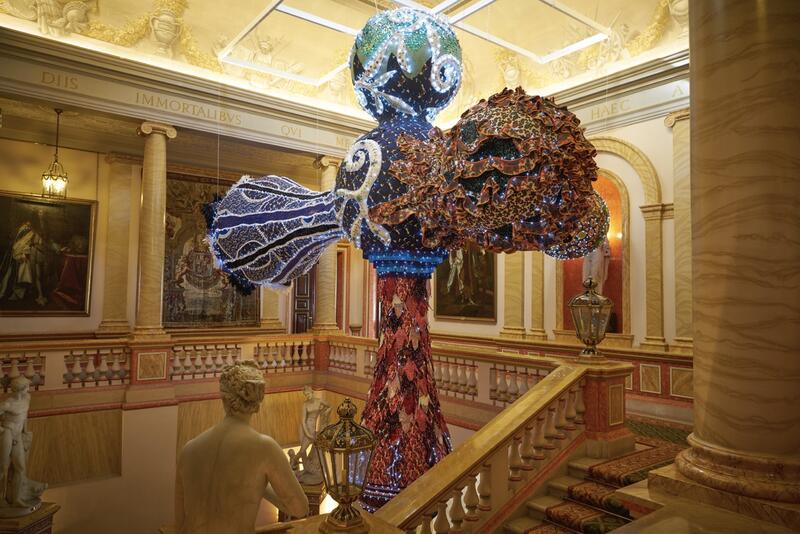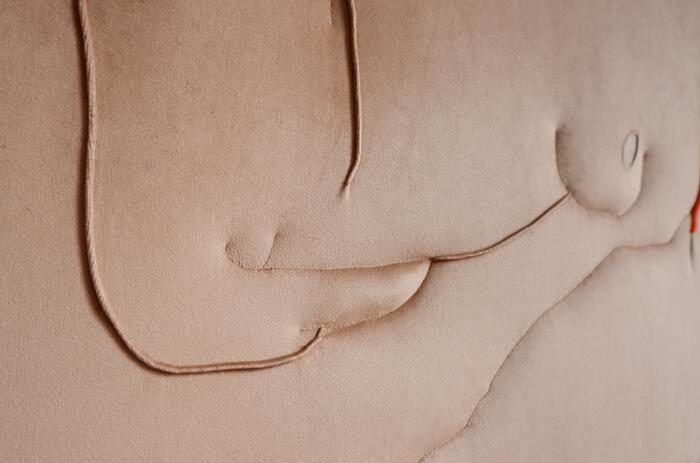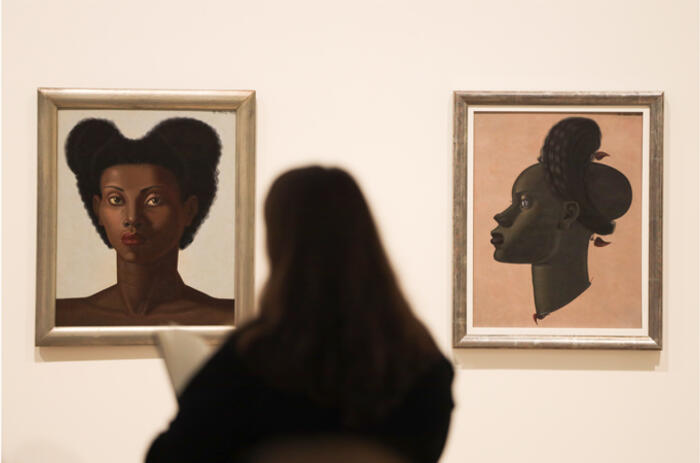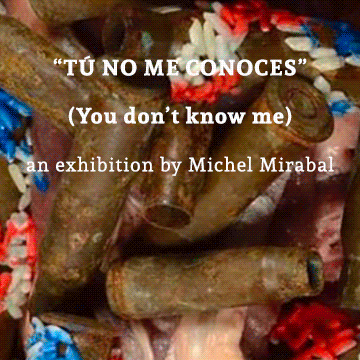THE PALATIAL EXTRAVAGANCE OF VASCONCELOS
Joana Vasconcelos (Paris, France, 1971) walks that fine aesthetic line between the overwhelming and the excessive. The artist does not hide her intentions—she never has—and if the ornate effect of her works is what she aims for, then the mission is accomplished. When faced with a production that is so clearly personal and deliberate, the setting can only serve to further amplify the challenge her installations pose to our ideas of beauty and artistic harmony.

The Liria Palace in Madrid, the official residence of the House of Alba, is now home to Flamboyant, a wide-ranging, almost spatial proposal in which the building becomes an ideal setting for the Portuguese artist’s premises. The effect produced by the placement of a substantial and representative selection of her large-scale works throughout the palace’s rooms is not only magnified—it also underscores the importance of the exhibition space itself. If we pay attention to the location, the chosen title, and, above all, the dialogue established between environment and aesthetics, the result does not stray in the slightest from the artist’s intentions.
The decoration and treasures of the House of Alba seem to extend that baroque fascination Vasconcelos embraces, an exuberance that is central to her artistic language. Her background as a jewelry designer, her devotion to textiles and tradition, and the scale of her installations all seem to align perfectly with the aesthetic extravagance in which she so comfortably operates. As a kind of prelude, Perruque (2012)—originally created for display at the Palace of Versailles—is present here and serves as a fitting bridge.
From the outset, with Solitaire (Solitário) (2018), placed in the garden at the palace entrance, blending gold tones and the clash between industrial components and decorative function, the viewer is encouraged to read beyond the object itself. The placement of the chosen works becomes an intrinsic element of the space. At times, the exhibition opts for a more evident connection—Carmen (2001) in the library, or the lobster protagonist of Le Dauphin et La Dauphine (2012), seated like a guest in the dining room.
Origin, identity, or belonging to the space are questions left for the viewer to ponder—likely while feeling overwhelmed by the overall effect. Take Vigoroso y Poderoso (2006), two lions covered in crochet guarding the vestibule: here we see how the presumed fierceness of the animals is undone by the calming, evocative effect of the handmade textile. At the same time, the work points to roots—the Azores as a geographic and symbolic origin, and possibly also diaspora. Beyond this, crochet as a technique also evokes tradition and social roles.
-
Joana Vasconcelos. Solitaire en Flamboyant. Foto: Juan Rayos
Piano Dentelle #3 (2016), installed in the music room, receives a new identity through its lace-like cover, while still preserving its core essence within an appearance of fragility. This concept is explored in various works, gradually shaping a sensibility in the visitor that is redefined with each piece. While this textile technique recurs throughout the exhibition, pride in heritage is also expressed in Coração Independente Negro (2006), a work formed by thousands of plastic forks that come together in the shape of a heart, pulsating to the fados of Amália Rodrigues.
Perhaps the most monumental piece is Valkyrie Thyra (2023). It encapsulates many of the technical lines and aesthetic outcomes that define Vasconcelos’s work, and its location contributes significantly to its grandeur. Against common logic, its installation within the stairwell gives it a new scale and physical prominence.
Amid such grandeur, Flaming Heart (2019–2024) is especially striking. This unsettling work transforms heart iconography into a living, organic presence that takes over the chapel. Its capillary-like structure creates a high-intensity sensory experience. The emotional and subjective realm often underpins Vasconcelos’s work, whether through visual impact or through the surprising use and recontextualization of materials. See, for instance, the giant bow in J’Adore Miss Dior (2017), made from perfume bottles, or the shoes crafted from pots and pans in Marilyn (2011), where, beyond the initial impression, a deeper feminist critique emerges—one that ties back to social commentary and gender roles.
Woven throughout the exhibition, deeper intentions unfold through other ambitious works. After the main gallery—which itself reconsiders the importance of location in shaping meaning—we reach La Théière (2025), the final piece of the show. This oversized forged Portuguese iron teapot was created specifically for this exhibition. Like many of her works, it will see its seemingly artificial quality altered by the natural influence of the space around it, as though the palace itself refused to let go of the spectacle of excess and opulence that defines this unmissable exhibition.
Flamboyant: Joana Vasconcelos at the Liria Palace can be visited until July 31 at the Palacio de Liria – House of Alba Museum Residence, Princesa 20, Madrid (Spain).
*Cover image: Joana Vaconcelos. Valkyrie Thyra, 2023. Photo: Juan Rayos.













